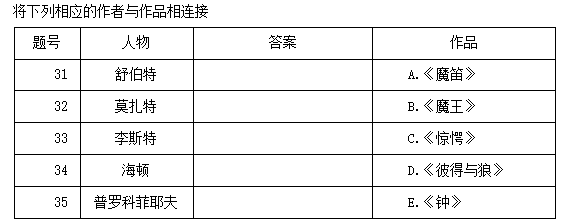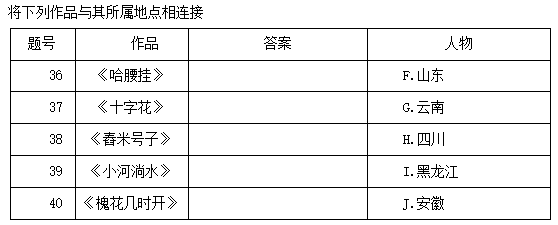根据下面资料,回答题
One of my children is spinning in a circle, creating a narrative about a princess as she twirls.?The other is building a rocket ship out of a discarded box, attaching propellers made of cardboard?and jumping in and out of her makeshift launcher. It is a snow day, and I've decided to let them?design their own activities as I dean up and prepare a meal. My toddler becomes the spinning?princess, imagining her character's feelings and reactions. What seems like a simple story involves?sequencing, character development, and empathy for the brave princess stuck in her tower. The?rocket ship my first grader is working on needs a pilot and someone to devise the dimensions and?scale of its frame; it also needs a story to go with it. She switches between roles and perspectives,?between modes of thinking and tinkering.?
This kind of experiential learning, in which children acquire knowledge by doing and via?reflection on their experiences, is full of movement, imagination, and self-directed play. Yet such?learning is increasingly rare in early-childhood classrooms in the U.S, where many young children?spend their days sitting at tables and completing worksheets. Kindergarten and preschool in the U.S.?have become more and more academic, rigorously structuring kids' time, emphasizing assessment,?drawing a firm line between "work" and "play"--and restricting kids' physical movement. A study?from the University of Virginia released earlier this year found that, compared to 1998, children?today are spending far less time on self-directed learning--moving freely and doing activities that?they themselves chose--and measurably more time in a passive learning environment.?
With so few years under their belts, my 3- and 6-year-old daughters are still learning to inhabit?their bodies. They are learning how to maneuver themselves physically, how to orient themselves in?space. As Vanessa Durand, a pediatrician at St. Christopher' s Hospital for Children in Philadelphia,?says, freedom of movement is necessary for children to meet their developmental milestones:?"Children learn by experiencing their world using all of their senses. The restriction of movement,?especially at a young age, impedes the experiential learning process."?
Movement allows children to connect concepts to action and to learn through trial and error. "If?you walk into a good kindergarten class, everyone is moving. The teacher is moving. There are?structured activities, but generally it is about" purposeful movement," comments Nancy?Carlsson-Paige, a professor emerita of early-childhood education at Lesley University and the author?of Taking Back Childhood, describing the ideal classroom setup. In the classroom culture she?advocates for,"[Kids] are getting materials for an activity, they are going back and deciding what?else they need for what they want to create, seeing how the shape of a block in relation to another?block works, whether they need more, does it balance, does it need to be higher, is it symmetrical.?All of these math concepts are unfolding while kids are actively building and moving."?
Research has shown time and again that children need opportunities-to move in class. Memory?and movement are linked, and the body is a tool of learning, not a roadblock to or a detour away?from it. Any parent who has brought home a kindergartener after school, bursting with untapped?energy yet often carrying homework to complete after a seven-hour day, can reasonably deduce why?children today have trouble keeping still in their seats. Many children are getting 20-minute breaks,?or none at all On Florida, parents whose children have no recess have been campaigning to legislate?recess into the curriculum.) Recess, now a more frequent topic of research studies, has been found to?have "important educational and developmental implications." Schools that have sought to integrate?more movement and free play, such as short 15-minute recess periods throughout the day, have seen?gains in student attention span and instructional time. As Carlsson-Paige points out, "Recess is not a?separate thing in early-childhood education."?
Ben Mardell, a professor of early-childhood education at Lesley University and the project?director of the Pedagogy of Play initiative at Harvard's Project Zero observes that even when adults?do incorporate play into learning, they often do so in a way that restricts free movement and agency.?"The idea that there should be formal instruction makes it no longer play," says Mardell. ?"In play?the player is choosing to participate, choosing a goal, and directing and formulating the rules. When?there is an adult telling the kids, ?'This is what we are supposed to do,' many of the important?developmental benefits of play get lost."?
The role of play has been established not just as a part of learning, but as a foundation for?healthy social and emotional function. The National Association for the Education of Young?Children has published widely circulated position papers on the need for developmentally?appropriate teaching practices and for reversing the "unacceptable trends in kindergarten entry and?placement" that have been prompted largely by policy makers' demand for more stringent?educational standards and more testing. Some teachers are enacting changes, seeking ways to bring?movement back into the classroom. Lani Rosen-Gallagher, a former first-grade teacher for New?York City public schools and now a children's yoga instructor, explains the shift in thinking: "I?would have [my students] get out of their seats every 15 minutes and take a Warrior Pose or Lion' s?Breath, and then I could get 15 more minutes of work out of them." This kind of movement, she?said, also gives children space to develop self-awareness and self-regulation, to get to know?themselves as thinking individuals by connecting with the body.?
Play-based preschools and progressive schools (often with open room plans, mixed-age groups,?and an emphasis on creativity and independence) are seeing increased popularity. Enrichment programs engaging children in movement with intention (yoga, meditation, martial arts) are also gaining traction.?
These kinds of methods seek to give children back some of the agency their young minds and bodies crave, as less play and mobility lead to an uptick in anxiety in ever-younger students and even, according to Durand, a growing number of cases of children who need to see occupational therapists. Mindfulness practices such as guided breath and yoga can help mitigate the core symptoms of ADHD in children, ?(an increasingly common diagnosis), while the arts encourage?self-expression and motor-skill development.?
Emily Cross, a professor in the School of Psychology at the United Kingdom's Bangor?University, explains the impact of movement on memory and learning: New neuroscience research,?she said in an email, shows that active leaming--"where the learner is doing, moving, acting, and?interacting"--can change the way the brain works and can accelerate kids' learning process. While?passive learning may be easier to administer, she added, it doesn't favor brain activity. Cross, whose?research focuses on pre-teens and young adults, said she's found ?"very clear evidence that when?learners are actively engaged with moving their own bodies to music, in time with avatars on the?screen, their performance is vastly superior to when they're asked to engage in passive learning ...?[There are] striking changes in brain activity when we combine dance and music in the learning?context." In other words, people absorb a newly acquired skill-set better while doing, engaging their?bodies rather than simply observing.?
These research findings echo the observations and methodologies of educators who promote?active learning. As Sara Gannon, the director and teacher at Bethesda Nursery School, a highly?regarded play-based preschool in New Haven, Connecticut, that favors experiential learning over?direct instruction, in an email notes: ?"Unfortunately, there has been so much focus on forcing the?academics, and young children are being asked to do what they are just not ready to do ... of course,?we do teach letters and sounds, numbers and quantities--but through experiences and within a?context. That means, hands-on: counting the number of acorns a child found on the playground,?building with unit blocks, sounding out a child's name as they learn to write it, looking at traffic?signs on a walk." Yet while such developmentally oriented programs may benefit children, for now?they're unlikely to become widespread given the current focus on assessment and school readiness,?particularly in underserved communities.?
As my girls continued creating their own activity stations and imaginary worlds, the contrast?between how children operate versus what is often expected of them was apparent. It would be?unwise and impractical to pretend that children do not need any structure, or that academic skills are?unimportant in school. Yet it is necessary to recognize that the early-childhood classroom has been?significantly altered by increasingly rigorous academic standards in ways that rarely align with how?young children learn.?
?
??According to the passage, what can we learn about experiential learning?查看材料
推断题。A项“它与儿童的智力水平有关系”,文章没有提到。B项“它让儿童自由地选择他们想做的事情”,原文第二段最后虽然提到了“doing activities that they themselves chose”,但也不是他们想做什么就选什么。C项“它对学业表现没有什么帮助”,文中多次提到了实验式学习对儿童认知发展的好处,这对学习肯定是有帮助的。D项“儿童通过实验式学习比被动学习学得更快”,第十段中提到“active learning--‘where the learner is doing,moving,acting,and interacting’ --can change the way the brain works and can accelerate kids’ learning process.While passive learning…doesn’t favor brain activity.”可知,D项表述正确。故选D。
随着期末考试的来临,一些学生表现出了担心、害怕、恐慌的心理。假如你是班主任,请你以“考前心理辅导”为主题,给学生设计一个主题班会方案(至少包括题目、设计依据、活动目标、活动内容与过程、预计效果、检验方案等)。
(单一主观题) 要求:
1.拟定活动方案的主题。
要求:主题鲜明,概括准确,字数不超过25字。
2.阐述活动方案设计的依据。
要求:清晰合理,表达简洁,字数不超过100字。
3.写出活动方案的目标、内容与过程。
要求:目标明确,内容充实,措施得当,具有针对性及操作性,字数不超过600字。
4.如果该方案付诸实施,你将如何评估其效果。
要求:指标恰当,方法可行,字数不超过100字。
案例一:
这学期,我新接手了一个班级。一段时间下来,一个叫小林的同学引起了我的注意。他平日里沉默寡言,总是穿着一身脏兮兮的校服,背着一个似乎从未洗过的书包。他座位前后排的同学桌子拉的都离他很远,下课也没有人和他玩,他好像坐在一个孤岛上。我曾试图与他交流,但他几乎不与我互动。
后来,从教过他的王老师那里了解到,小林从小父母离异,双方都不愿抚养他,是他年迈多病的奶奶一直照顾着他。王老师叹了口气,说道:“这孩子挺可怜的,可他自己也不争气,学习不上心,还不讲卫生,你看他的手、脸几星期都不洗一次,老师们说了多少次,他还是那样。班里同学也不喜欢他,不知谁给他起了个外号‘臭鼬’,就这样传开了。咱们想帮他也是心有余而力不足啊……”
听了王老师的一番话,我心里很不是滋味,作为小林的班主任,我必须帮他。第二天,我在办公室放了一条新毛巾,等小林到校后,把他叫到办公室,让他把手、脸洗干净,把镜子放到他的面前,夸了他一句“看,还是挺帅的嘛”。他显得有些不好意思,我顺势鼓励他要保持讲卫生的好习惯。此外,在课堂上我给了他更多的关注,让他回答一些力所能及的问题,并及时给予鼓励和表扬。课后,我找机会跟他聊天,当面批改他的作业,并对他的错题进行针对性地讲解。
一段时间后,我发现小林的个人卫生习惯有所改进,学习也有所进步,可他似乎还是有意无意的躲着我,课间总是一个人在座位上发呆,既不跟同学玩也不跟老师聊天。看得出来,他依然没有朋友,还是那么孤独。
案例二:
张老师是某班的班主任。接手前,他就听说本班有几个不大好管的学生,经常上课捣乱、不交作业,学习成绩差,隔三差五的就会被老师批评,是老师办公室的常客。
张老师一接手,就分别找这几位学生进行了一次深入的谈心,并与他们的家长进行了沟通,刚开始这几位学生有明显进步,张老师感到很欣慰。可是没过多久,张老师就有些焦头烂额:
英语老师拿来一张学生名单,说:“你们班这几个学生已经好几天没交作业了,怎么催都交不上来。”
数学老师也来找,说:“这次测验,你们班这几个学生又只考了20多分,自己还不当回事,让改错也不改,这学生没法救了!”
德育主任找张老师谈话,说有几个学生频繁迟到,导致他们班在本月的学校班级量化考核中成绩倒数第一。
……
张老师发现所有问题都跟那几个学生有关。班级其他学生也来告状,说他们上课几乎不听讲,小动作不断,经常说话,有时还打闹,不仅影响大家的学习,还害得班级被扣分,老师提醒也不管用,能不能别让他们在这个班了。
(单一主观题) 请根据以上案例,回答下列问题:
1.请结合案例一,谈谈作为班主任应如何对待和帮助班级中像小林这样的学生。
要求:有针对性,条理清楚,字数不超过300字。
2.假如你是案例二中的班主任张老师,将如何帮助班上那几位学生建立良好的学习习惯?
要求:方法得当,措施合理,条理清楚,字数不超过400字。
3.透过以上案例,谈谈如何引导学生建立良好的同伴关系。
要求:全面、准确、条理清楚,字数不超过400字。
当学生学业失败时,教师只要引导他做努力归因就能激发其进一步学习的动机。
要求:对上述观点作出判断和分析,条理清晰,不超过400字。


歌曲《阳关三叠》
教材来源:苏教版音乐教材九年级上册第五单元《悠远古风》
答题要求:
一、根据九年义务教育课程标准完成一课时(45分钟)的教案。
二、围绕所制定的课时目标,设计科学、可行、有效的教学过程。
音乐的审美功能。
《如歌的行板 》是俄国作曲家( )作品.
小号是( )乐器,音色燎亮辉煌,善于表现雄壮有力的音乐情绪,还能吹奏优美如歌的旋律。
《我是城里的大忙人 》是意大利歌剧作曲家_________写的.他的歌剧有《 》《 》《》
将八度分成十二个均等半音的律制,称为 ( )。